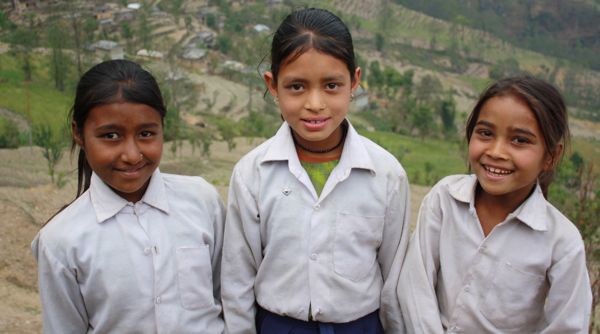
Chaukati schoolgirls. All photos by Sarah Vazquez
If you are headed to Nepal, take note of these quintessential keywords. Remember, you are not aiming for fluency; you are aiming for safe water, a settled stomach and happy hosts.



Chaukati schoolgirls. All photos by Sarah Vazquez
If you are headed to Nepal, take note of these quintessential keywords. Remember, you are not aiming for fluency; you are aiming for safe water, a settled stomach and happy hosts.
1) Namaste vs Tik Chha
Let’s start with your first word, namaste.
This is used as both a greeting and a goodbye and is accompanied by holding your palms together in a prayer position. When you meet people, say “namaste,” and hold your hands together in front of you.
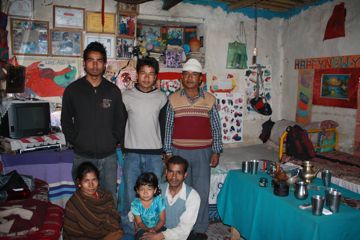
A family poses for a photo after hosting me for chiyaa.
Strangers, shopkeepers, fruit venders, farmers, bus drivers, and policemen will all appreciate your courtesy.
Be careful not to be overzealous with your namastes; you do not need to say namaste to people more than once in the day.
Do not say namaste to your hostel owner every time you walk to your room. Using namaste properly will make you a language connoisseur, not a language kook.
Instead of namaste, you can casually say, Tik chha?
When you say Tik chha? as a question, it is an inquiry, “Are you okay? How are you? How are things? How is the day?”
When you say it in response to a question or in the context of a conversation, it means general satisfaction, “I am well. This tea is good. This shawl is good for me. Today is a good day.”
2) Diddi, Dai, Bai and Bahini
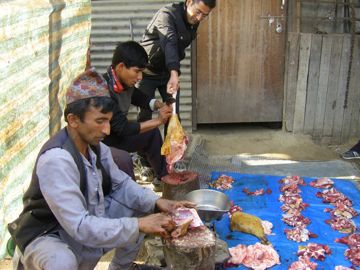
A typical Saturday morning activity.
Family is very important in Nepal. It is not uncommon for the first question from a street vender to be, “Do you want fruit?” and the second question to be, “How is your mother?”
In Nepali, people often address each other by an affectionate, familial nickname, such as: Diddi (older sister), dai (older brother), bai (younger brother), or bahini (younger sister).
Often times one of these nicknames will be used after a name to add respect and formality. If I were talking to my teacher, Sweta Gurung, instead of saying, “Namaste Ms. Gurung,” I would say, “Namaste Sweta Diddi.”
These nicknames are also an endearing sign of friendliness. Next time you go get a cup of chiyaa try saying, “Namaste, Diddi,” when you order.
If you yourself are called any of these nicknames, rest easy knowing that it is a compliment and shows that you are liked.
3) Kanna, Chiyaa, Piro, Umaleko
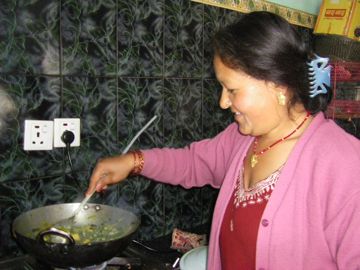
“Ramro kanaa!”
Along with family, food is also sacred; good food is a sign of a good host.
Kanna: “food.”
If a friend, or even a stranger, is talking to you, then any sentence with kanna in it is a good thing and usually means you are being invited to eat.
If you have not eaten when you arrive at someone’s house, it is usually an unacceptable way to continue with the day. You will be fed.
Piro: “spicy,” or, “hot.”
Simply ask, “Piro?”
No matter what you think of your spice tolerance level, Nepal has spice like you’ve never tasted before. Do not underestimate the chilies or the cooking.
If your host says it’s piro, then it’s Nepali hot. Proceed with caution.
Chiyaa: “tea.”
Like kanna, chiyaa is always a good thing. It is very safe to say that if you arrive in any store, home or office at the right time of day (any time of day) then you will be offered a cup of chiyaa.
It would be incredibly rude to not offer a guest chiyaa, and doubly rude to not offer a foreign guest chiyaa.
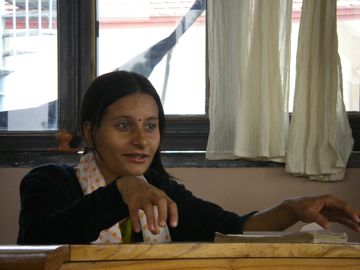
The Nepali guru herself, Manju Diddi.
Likewise, it is rude for you to not accept. It doesn’t matter if you don’t want a cup and it doesn’t matter if you have somewhere to be.
Try your hardest to accept a chiyaa invitation; accepting hospitality is the best way to repay hospitality. Usually, chiyaa implies, dude chiyaa (milk tea). You can ask for calo chiyaa if you don’t like milk and this will get you plain black tea. There is always a hefty amount of sugar included.
Umaleko paani/filter-ko paani: “boiled water/filter water.”
Tap water is not safe to drink in Nepal. Simply ask “Umaleko paani?” or “Filter-ko paani?”
It’s worth asking at least twice, because you need clean water to be a steadfast rule of your eating habits.
Ramro: “Great. Good. Beautiful. Enjoyable. Pretty. Excellent. Tasty.”
Ramro can mean any and all positive adjectives. Use it to describe, review or request any food, clothing, housing, tea, adventure, or person. For example:
“How is your mother?”
“Ramro!”“How was the chiyaa?”
“Ekdahm (very) ramro!”
Parchha/pardina: “I need/I don’t need.”
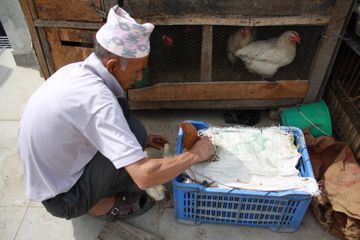
Many Nepalis have their own chickens so that they can eat fresh eggs everyday.
This is a very useful phrase. Put a noun in front of parchha and you almost have a full sentence! For example:
“Ma umaleko paani parchha (I need boiled water).”
You can use pardina with the same structure. However, if you are being pestered to buy, eat or accept something, you can simply say, “Pardina, Dai,” and this should tell your annoyer that you “don’t need it.”
This technique is handy in shops and on the street.
Homework garchuu:
Garchhu comes from the verb garnu (to do).
In Nepal education is taken very seriously and children are always doing homework. If you are a young traveler and find that you need to take a break from your hosts, you can simply say “Ma homework garchhu.”
Although you may think this is a nerdy excuse, it is the closest excuse that can get you out of a three hour long dinner conversation (which you can’t understand) and having to eat third helpings of daal bhat.
Pugyo: “Full.”
This is possibly the most useful phrase you will need to know. It is very rude for a Nepali host to leave their guest with an empty stomach.
When you are in a home and sit down for a meal, your plate will be overloaded with filling carbohydrates and there will certainly be seconds for you to eat. Before touching your food, separate the plate in two portions and say, with your extensive vocabulary,
“Pardina, Diddi.”
Make sure to smile. As long as you haven’t touched the food, your host can take it back and hopefully you have not offended her.
When she comes around to give you a second helping and you are already full (you will be full), hold your plate back and say with a big smile:
“Pugyo, Diddi.”
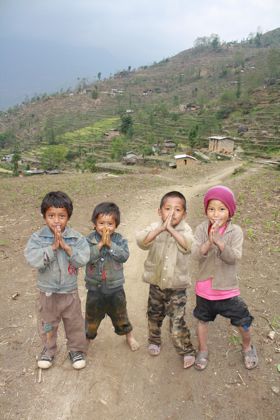
Namaste!
To be safe, hold a hand over your plate so she doesn’t dump food on it anyway.
A few belly rubs and “mmm” noises, along with a “ramro” review, will tell her you loved her cooking but you just can’t eat any more.
When navigating Nepal and its language, do not get discouraged by the lack of familiarity. You will probably not be able to say these phrases in a grammatically correct way all the time, but that is irrelevant.
A willingness to try, a lack of self-consciousness, some good body language and these key words will get you far!
Most Nepalis in and around Kathmandu, especially the children, will speak at least a little bit of English. They will be incredibly curious about you and eager to practice their English.
They may ask you things about your mother and how expensive your shoes were. Sometimes Americans can be offended by these personal questions, but to a Nepali this is their way of showing interest and concern.
Do not be offended and try to be as open and responsive as possible; soon these conversations will become an endearing and heartwarming part of your visit.
***I owe much credit to my fabulous language teacher in Kathmandu, Manju Diddi.***